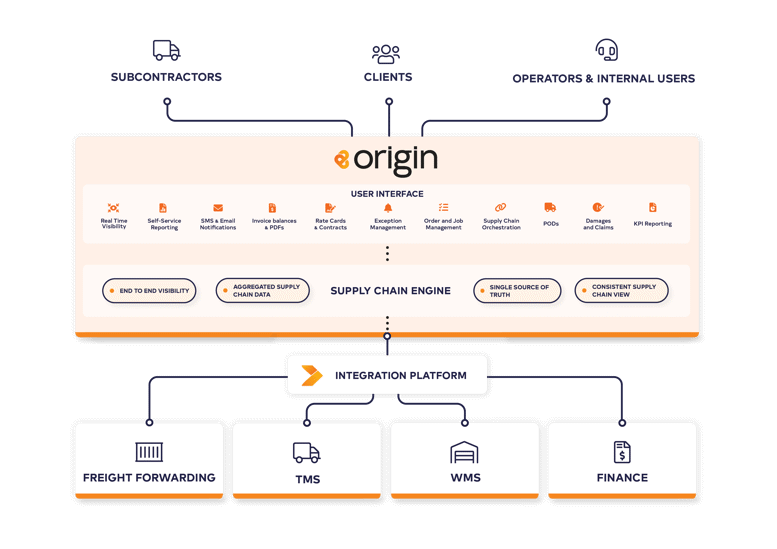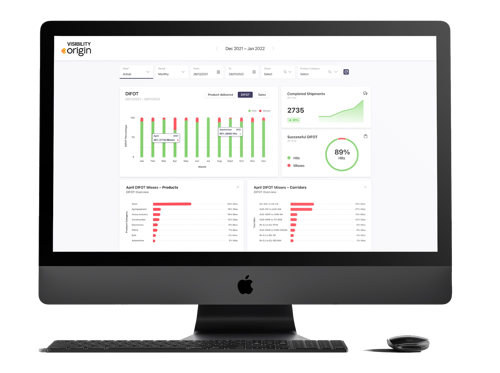Now, more than ever, customers expect transparency, visibility and accountability from their logistics providers so they can respond and adapt when supply chain disruptions occur. Delays can happen but if you can’t quickly provide an answer to “where’s my stuff?”, your customers aren’t likely to stick around.
Whilst achieving supply chain visibility is a necessary first step to this, the next requirement is making that visibility accessible to the customer through a user-friendly interface. This is when a customer portal can make all the difference as it can help to reduce administrative workloads for your own team and improve the overall customer experience.
A customer portal is a web application that displays information from multiple systems so customers can view and manage their data through a single system or login.
Most commonly, a supply chain portal enables customers, as well as your team, to access and manage real-time information such as the status of orders and jobs, KPI tracking, reporting and inventory visibility.
A great customer portal is often determined by the underlying supply chain platform that it’s built on. The supply chain platform is responsible for aggregating and contextualising all of the available data into a ‘single version of the truth’ for full visibility of the chain. With this in place, a customer portal can then present this richly contextualised and real-time data to both customers and internal users.
Customer portals are proving popular among outsourced logistics providers to improve their customers’ experience through self-service supply chain visibility and order management tools.
The complex nature of supply chain management means there are several specialised systems (WMS, TMS, Telematics and Asset Management etc) and external parties used to transport and store customers’ goods. This often results in data silos and double entry of key data, making it difficult to track down information quickly.
Each system is responsible for important supply chain activities that make up a complete supply chain view. By integrating and consolidating that information into a single user interface, logistics operators can provide customers with a self-service portal that allows them to view all of their data in real-time. Not only does it benefit the customer, but it can also reduce workloads for customer service requests, phone calls and emails that all take up internal time and resource.

Here’s our top six functions that we believe make a great customer visibility portal:
Integration via EDI or API is common practice and critical to supply chain visibility. In the context of a customer portal, integration typically starts with combining data from your existing internal systems. Ensuring that you can push and pull data from each system so that they can effectively ‘speak to each other’ is fundamental to a customer portal’s performance. This will then extend into integration with customers and suppliers, to enable automation of orders, invoices, job status and other events or updates.
Your portal should not only provide visibility of orders but also allow new orders and jobs to be created based on the specific operation or client contract that has been configured in the core supply chain system. As each customer’s supply chain will be different, the ability to configure the portal to match those specific needs is central to creating a good user experience.
While integration with customers and partners is key to automation and getting visibility of data, not all customers have the integration capability to do so. For this, your portal should provide customers with the functionality to create their own orders quickly and easily. This removes the need to spend time checking phone calls and emails, whilst also gaining vital visibility of that order. The portal will then be able to push the newly created order to the relevant systems where each activity can be executed on.

Each customer will have different contractual KPIs and order types that your business is delivering to, so it's important that your customer portal is configured to reflect that. Standard milestone and event tracking, KPI dashboards and even self-service report building should all be key features for the customer that shows your organisation takes accountability for its service and performance.
Regardless of what goods are involved, a good customer portal should integrate and pull all inventory data, such as current stock on hand from the Warehouse and what is currently in transport from the TMS, into the dashboard to provide the big picture view for customers.
Ensuring the right supply chain information is available to the right person at the right time is critical. The portal should have clear user management permissions, SSO authentication and customer self-service user management to ensure your supply chain data, and that of your customers, is kept secure and safe.
Our client’s often come to us with different understandings and expectations of what a customer portal does. In most cases, only the basic ‘track and trace’ use is considered. But a customer portal can provide so much more functionality and benefits that help differentiate your services and improve the total experience for your customers and your team.
It also serves as a starting point for utilising supply chain visibility beyond customer order tracking. With Origin’s platform and customer portal in place, your organisation can begin to streamline its own processes through better visibility and understanding of your operations.
© Copyright 2024, Sandfield Associates Limited. All Rights Reserved. Privacy Policy